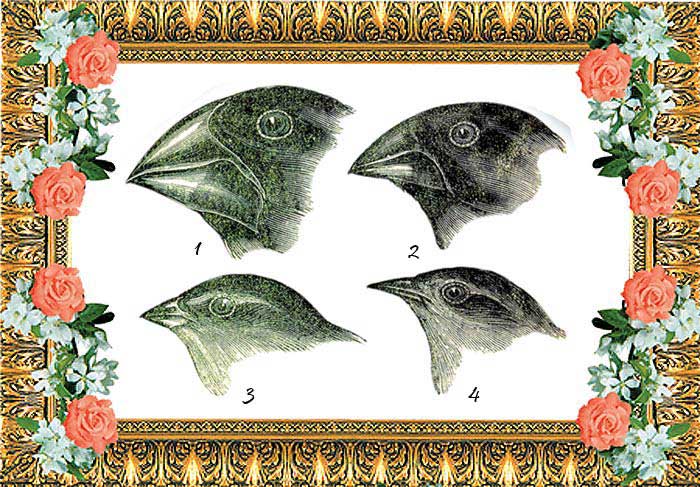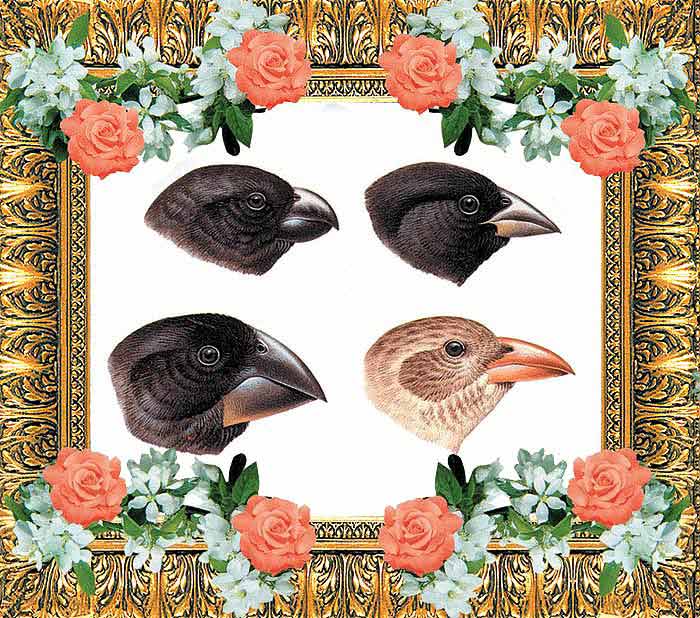...He has no partner in the Kingdom. He created Everything and determined it most exactyl. (Surat al-Furqan, 2)
The True Story Of The Galapagos Finches

Books about the life of Charles Darwin and the development of his theory always give special importance to the Galapagos Islands in the Pacific Ocean. These islands are even mentioned in some biology textbooks, since the Galapagos were a source of inspiration for Darwin as he drew up his theory. Evolutionists describe these islands as a place where the foundations of the theory of evolution were laid, and as "Darwin's laboratory." As a result of the 20th century's intense Darwinist propaganda, the Galapagos have acquired great fame .
These small islands lie fairly close to one another, some 1,000 kilometers off the coast of Ecuador, to the west of the South America. They are all volcanic in origin, having emerged from magma thrown up by a volcano several million years ago.
During his five-year voyage on the explorer vessel H.M.S Beagle, Darwin landed on the Galapagos in 1835, and spent several weeks there conducting observations. The diversity of plant cover and animal life on these islands, so distant from the mainland, made a great impression on Darwin.
The Galapagos Islands are a region containing a very large number of different plant and animal species—various tropical plants as well as finches, flamingos, penguins, giant tortoises, iguanas, seals, butterflies, and insects. Forty-two percent of the plants found on the Galapagos, 75% of the bird species, 91% of the reptiles and all of the mammals are unique to the islands, not found anywhere else in the wild.214
The unique Galapagos finches made these islands a landmark of Darwinism. There are 13 species of finches on the Galapagos Islands, and another one on Cocos Island, some 600 kilometers to the northeast. The scientific literature refers to these 14 species as Galapagos finches or Darwin's finches. The birds finches vary between 7 and 15 centimeters in length, and generally have dark-colored feathers. Being rather tame, they do not fly for very long distances. Although 14 different species have been classified, they bear a close resemblance to one another, exhibiting similar body shapes, colors and habits. Ornithologists distinguish between them mainly on the basis of beak shape and body size.

The discovery ship H.M.S. Beagle.
These birds' profound influence had on Darwin is described in various accounts:
The finches, then, did play a role in the formulation of Darwin's theory and they became an important part of his evidence for the role of natural selection in evolution.215

In fact, Charles Darwin looked to 13 different species of finches from the Galapagos Islands to help bolster his theories of evolution. 216
Evolutionists ever since Darwin have claimed that the present-day Galapagos finches evolved from a single species that arrived long ago from South America. At every opportunity, they use these birds as an example of evolution through natural selection, and portray them as one of the best-known proofs of evolution. Morever, evolutionists claim that studies on the finches provide an overwhelming evidence for the role of evolutionary process in generating the extensive biodiversity.217
Evolutionists refer to how different forms emerge as the result of a single species settling in various environments as adaptive radiation. They portray the so-called evolution of finches living on the Galapagos as a classic example of this; and may go even further and claim that the same process can be observed today.
Professor Ali Demirsoy, who devotes considerable space to the theory of evolution in his books, describes the Galapagos finches as a good example of adaptive radiation:
Adaptive radiation can be seen on a small scale in the finches living in the Galapagos Islands . . . Some of these birds are ground-feeders, eating cereals and seeds, others live in the trees, feeding on insects, while others still live in certain cacti, feeding on their seeds. But these birds, which all share the same origin, display a striking level of adaptive radiation in terms of their beak size and shape.218
According to Hau and Wikelski, Darwin's finches are "are a textbook example of adaptive radiation" and "one of the most convincing evidences for ‘evolution in action'.219
This chapter shall examine Darwin's and his followers' errors regarding these finches, and show how these birds reveal no evidence for the theory of evolution.
First, we can briefly touch on the classification of these birds in the scientific literature.
The Classification of the Galapagos Finches
In terms of anatomy, behavior and ecology, the Galapagos finches are divided into 14 species. Because six of these feed on seeds on the ground, they are known as ground finches. These in turn are divided into three types, according to their body and beak size: the great ground finch (Geospiza magnirostris), the medium ground finch (G. fortis) and the small ground finch (G. fuliginosa). The other ground finch types include the great cactus-eating ground finch (G. conirostris), which has a longer beak and eats cactus flowers and fruit pulp in addition to seeds, the small cactus ground finch (G. scandens), and the sharp-beaked ground finch (G. difficilis), which eats the eggs of other animals and feeds on blood, as well as seeds.

1. Geospiza magninostris 2. Geospiza fortis 3. Geospiza parvula 4. Certhidea olivecea
Six of the Galapagos species are tree finches. Apart from the vegetarian finch (Platyspiza crassirostris), these all feed on insects. The woodpecker finch (Cactospiza pallida) holds a cactus thorn in its beak to extract insects from their hiding places. The mangrove finch (C. heliobates) uses its thick, flat beak to catch insects in the swamps. The other three tree-dwellers are the greater tree finch (Camarhyncus psittacula), the medium tree finch (C. pauper) and the small tree finch (C. parvulus). The vegetarian finch eats leaves, seeds, fruits and flowers with its short, slightly curved beak.
The warbler finch (Certhidea olivacea) has a small, thin beak and hunts insects. The Cocos Island finch (Pinaroloxias inornata) is the only species living outside the Galapagos Islands, and feeds mainly on insects in trees and on the ground.
Every species of finch is equipped with a beak structure responding to its food requirements. The beaks of the Galapagos finches may be compared to pincers and files, each specially designed for different purposes.

The Emergence of the "Darwin's Finches" Myth
In fact, it's rather surprising that finches living on the Galapagos Islands should have been given Darwin's name, because he was not the first one to discover them. Actually, they had been known for a long time before. Captain James Colnett, for example, had referred to them back in 1798.220 Furthermore, contrary to what most people imagine, while Darwin was on the Galapagos Islands, his observation of the finches was rather superficial. His travel notes contain only one reference to the finches, and that he never mentions them at all in The Origins of Species.221
In fact, Darwin attached importance to the finches only long after his voyage. While he was actually on the Islands, he did not find them worthy of much interest, collecting specimens of only nine of the 13 species. And he described only six of these as finches, describing the others as other species of bird. In short, he was unable to fully distinguish the finch species, and also failed to establish a connection between beak shape and feeding habits. He did not even note which bird species was particular to which island. As stated by Michaela Hau and Martin Wikelski of University of Illinois "Due to this oversight during his visit of the Galapagos archipelago, Darwin did not recognize the potential importance of the finches for the theory he developed later.222
The well-known British ornithologist John Gould studied in detail the finch specimens Darwin had collected in 1837, and concluded that these birds were unique to the Galapagos and that most of Darwin's records were wrong. Examination of the finches caught by the Beagle's crew and the regular records they kept brought Darwin's errors to light.223
Frank Sulloway, a historian of science, stated that with regard to these birds' feeding habits and geographical distribution, Darwin's thinking was limited and, to a large extent, incorrect.224 About the claim that Darwin took the Galapagos finches as evidence for evolution, Sulloway said. "Nothing could be further from the truth"225
In short, following long years of traveling, Darwin concluded that the finches could represent an example of evolution—but in so doing, he based himself of deficient and mistaken data. Actually, it was in fact not Darwin who mythologized the Galapagos finches, but 20th century evolutionists. The term Darwin's finches was first used by Percy Lowe in 1936, and the ornithologist David Lack spread the use of the term. Lack's 1947 book Darwin's Finches was a standard-bearer for evolutionary propaganda in this area.226 With his support for neo-Darwinism's claims, he made the tale of Darwin's finches known to everyone; their so-called evolution has since been studied more than the other bird families.227
Research After Darwin
As early as the late 19th century, a flood of visitors began arriving at the Galapagos Islands. The visitors and researchers, most of them American, collected thousands of bird specimens. For example, the California Academy of Sciences alone added more than 8,000 birds (including Darwin's finches), to its collection in 1905-1906.228 Galapagos finches soon found their way into many museum collections—not without an objective, of course. The aim was to complete the work that Darwin had left half-finished and to rescue evolution from its predicament by finding valid evidence.
There was another important reason for the last century's evolutionary research into the Galapagos finches. In The Origin of Species, Darwin had written that a new species' emergence by way of natural selection was a very slow process, for which reason it could not be observed, but only deduced. This was not acceptable by the standards of developing science. Neo-Darwinists embarked on a search for new evidence on which to maintain their claims that evolution was scientific. At this point, the story of the Galapagos finches came to be regarded as saviors.
These birds became the focus of wide-ranging studies. Many evolutionists issued statements based on their observations. In an article in the April 1953 Scientific American, David Lack claimed that the evolution of the birds on the Galapagos Islands had taken place recently, for which reason the islands were an exceptional place.229 Another evolutionist, Peter Grant, even maintained that the Galapagos finches were still evolving.230
One can see the names of Peter and Rosemary Grant in most articles and papers about these finches. These two researchers first went to the Galapagos Islands in 1973 with the aim of seeing the effect of evolution on the finches, and have carried out detailed observations and studies ever since. They are thus considered experts on Darwin's finches.231
Peter Grant and His Wife on the Galapagos

These two, who are currently continuing their research at Princeton University's department of Ecology and Evolutionary Biology, spent many years on Daphne Major, one of the tiny Galapagos Islands, studying the middle ground finch. They recorded the measurements of the beaks, wings and bodies of the birds they caught with the help of nets, and after attaching a special band to each one they set them free again. By 1977 they had marked the majority of the birds on the island, and almost all of them by 1980.
In this way they regularly monitored some 20,000 finches from generation to generation. The absence of human beings and predators on this island made the finches so tame as to be effectively domesticated. This made their work very much easier. In addition, Professor Grant and his wife regularly measured the amount of rain falling on the island.
Most research regarding Galapagos finches was carried out in the birds' natural habitat. Peter and Rosemary Grant and their assistants observed the birds under various climatic conditions and sought to identify the effects that alleged evolution had on them. Note that all the researchers involved in these studies believed that all living things are the result of evolution and had set to confirm, through their observations, this belief to which they were so devoted.
As for the climatic conditions on the Galapagos, there is usually a hot and rainy season between January and May, with the other months being cooler and drier. In addition, there may be wide variations between the initial and total amounts of rainfall in the hot, rainy season. Moreover, the atmospheric phenomenon known as El Niño takes place at irregular intervals every two and 11 years, and at different levels of intensity, also alters the climatic balances. At such times there is excessive rainfall; subsequent years are then generally dry and arid.
The level of rainfall is of vital importance to the ground finches that feed on seeds. In years of plentiful rain, ground finches can easily obtain the seeds they need to grow and breed. In years of drought, however, the plants on the islands may produce a limited and inadequate amount of seeds, as a result of which some finches starve.
Grant and his colleagues measured the rainfall on Daphne Major as normal in 1976, but counted only one-fifth of this amount a year later, in 1977. During the 18 months of drought from the middle of 1976 to January 1978, there was a significant drop in the quantity of seeds on the island and a major reduction in the numbers of ground finches. The population fell to 15% of the year before. They assumed that most of the other birds had died, and that a few had migrated.

In fact, Peter Grant and his wife put a lot of hard work into their research on the Galapagos Islands. Yet when evaluated, all their care and attention bore no fruit. They committed a serious error by interpreting their findings according to evolutionist preconceptions, rather than scientific evidence.
Grant and his team made another important observation, noting that the finches that survived the drought were rather larger than normal and had slightly wider beaks. The average beak of the ground finches on the island in 1977 was approximately half a millimeter deep, 5% greater than the average in 1976. (Beak depth is the distance between the topmost and lowest points where the beak joins the head.) Starting from this point, the researchers claimed that natural selection had separated out those finches feeding on seeds alone, and that those birds with beaks large enough to open large, hard seeds had managed to survive.
In an article in the October 1991 Scientific American, Peter Grant announced that this research offered direct evidence of evolution. According to him, 20 cases of selection were sufficient to turn a middle ground finch into a great ground finch. Assuming that drought occurred once every 10 years, this change could take place in as little as 200 years. Adding in a margin of error, Grant maintained that this transition could also last as long as 2,000 years—but that bearing in mind the length of time the birds had existed on the island, even this figure was very low. He suggested that natural selection would take longer to transform a middle ground finch into a cactus ground finch.232
Grant reiterated these claims in subsequent articles, insistently maintaining that the finches had confirmed Darwinism and was proof that natural selection, via environmental pressure, caused organisms to evolve.233
Evolutionist circles regarded these statements as a lifesaver. They were portrayed as evidence of evolution through natural selection, a process that had hitherto always been refuted by experiment and observation. The Grants' researches were made the subject of Jonathan Weiner's Pulitzer prize-winning book The Beak of the Finch. In that 1994 book, Weiner described this change in the beak as "the best and the most detailed demonstration to date of the power of Darwin's process."234 Again according to Weiner, the finch beak was an icon of evolution.235 With his book's publication, Peter and Rosemary Grant became heroes of Darwinism.
Indeed, Professor Grant and his team put in a lot of hard work and field research on the Galapagos, but failed to display the same care and attention in analyzing their results. They fell into a grave error because they set about evaluating their findings, not according to objective scientific logic, but in the light of their evolutionist preconceptions.
The Beak-Change Error

Evolutionist researchers ascribe fluctuations in the beaks of "Darwins's finches' to evolution, but this is completely ideological.
Every few years, as already mentioned, El Niño affects the western regions of North and South America in particular, and at such times, high levels of rain fall on the Galapagos, leading to increased plant growth and an abundance of seeds. Ground finches are therefore easily able to find the food they need, and their numbers accordingly increase after such rainy periods.
Grant and his colleagues witnessed a similar situation in 1982-83. With the rains, seeds became plentiful, and the average beak size of ground finches returned to the pre-1977 drought levels. This greatly surprised the observers, who were expecting a continuing "evolution" in beak size.
The change in Galapagos finches' average beak size actually has a different explanation: In years of drought when seeds are scarce, birds with beak a slightly larger than normal can open the remaining hard, large seeds with their more powerful beaks. Weaker individuals in the finch population, with smaller beaks, die off since they are unable to adapt to the prevailing conditions. And thus, the average beak size increases. In rainy periods, on the other hand, when there is an abundance of small, soft seeds, the process works in the opposite direction: Ground finches with smaller beaks can better adapt to their environment, and their numbers increase. Thus the average beak size returns to normal. In fact, Peter Grant and his student Lisle Gibbs admitted as much in an article published in Nature magazine in 1987.236
In short, facts clearly reveal no such thing as evolutionary change. Average beak size may fluctuate according to the rainfall, sometimes increasing or decreasing around a fixed level, but there is no question of a net change.
Aware of this, Peter Grant said that, "the population, subjected to natural selection, is oscillating back and forth."237 Some evolutionist researchers say that natural selection works in two mutually opposed directions.238
No matter how much a clock pendulum may swing back and forth, it never records any net progress. That will still apply if you operate a pendulum perfectly for millions of years.
Danny Faulkner, a professor of Astronomy and Physics at South Carolina University, states that the finch beaks' fluctuations cannot represent evidence of evolution:
"And so if you have supposed microevolution one direction and then later it reverts right back to where it started from, that's not evolution, it can't be."239
The average size of the Galapagos finches' beaks increases or decreases according to food resources, but the way that evolutionist researchers imagine they have found evidence for evolution in fluctuations in the finches' beak is completely ideologically based.
The Finch "Evolution" Deception
To recapitulate, following their examination of thousands of ground finches (Geospiza fortis) from the 1970s to the 1990s, Grant and his team observed no net increase or decrease in beak size. Moreover, no new species or characteristic emerged, and they observed no net change in any direction.
An objective scientist's task is to report that fact without speculation or distortion. It is unacceptable to exaggerate a phenomenon or to distort its true significance for the sake of producing evidence for any theory. Yet Professor Grant's analysis was completely opposed to his findings; he made a claim of a phenomenon that he never observed, that one finch species could turn into another in as short a time frame as 200 years, and he thus cast a serious pall over his own research. In the words of the California University biologist Dr Jonathan Wells, this is "exaggerating the evidence."240
Wells states that Darwinists frequently resort to such methods, and cites as an example some expressions in a pamphlet issued by the American National Academy of Sciences:
A 1999 booklet published by the National Academy describes Darwin's finches as "a particularly compelling example" of the origin of species. The booklet goes on to explain how the Grants and their colleagues showed "that a single year of drought on the islands can drive evolutionary changes in the finches," and that "if droughts occur about once every 10 years on the islands, a new species of finch might arise in only about 200 years."
That's it. Rather than confuse the reader by mentioning that selection was reversed after the drought, producing no long-term evolutionary change, the booklet simply omits this awkward fact. Like a stock promoter who claims a stock might double in value in twenty years because it increased 5 percent in 1998, but doesn't mention that it decreased 5 percent in 1999, the booklet misleads the public by concealing a crucial part of the evidence. 241
It is astonishing that the respected and trustworthy American National Academy of Sciences should employ such a deception to look for evidence for natural selection and evolution in finches' beaks. Berkeley University's Professor Phillip Johnson said so in an article in the Wall Street Journal:
"When our leading scientists have to resort to the sort of distortion that would land a stock promoter in jail, you know they are in trouble."242
In sum, the story of the Galapagos finches, claimed to represent one of the most impressive examples of evolution through natural selection, is a clear deception—but only one of hundreds of similar examples of evolutionists resorting to unscientific methods.
The Speciation Error
It has long been known that it is difficult to distinguish between Galapagos finches because of their similarity. Ornithologists have often written that doing so requires considerable expertise.243 Therefore, the classification of these finches into 14 separate species is the subject of controversy among ornithologists.
To recapitulate, a species is defined as a population consisting of individuals with similar structural and functional characteristics, able to mate only with one another in nature, and which are unable to mate successfully with other individuals outside their own population. According to this definition, it is incorrect to divide Darwin's finches into 14 distinct species, because a significant proportion of them have been observed to interbreed. Indeed, Professor Grant admitted that six separate species could be recognized instead of 14, and in later studies he admitted that this figure could be lowered still further.244

Genetic investigation of the Galapagos finches has shown that there is no genetic difference among them.245 For example, a joint study by researchers from the Max Planck Institute and Princeton University in 1999 announced that the traditional classification of Galapagos finches was not apparent at the molecular level.246 Hau and Wikelski express the same:
"There is no evidence for an absolute genetic barrier between Darwin's finch species, thus many species can potentially hybridize.247
In conclusion, the Galapagos finches are all subspecies of a single species. What Darwin saw on and imagined to be evolution was actually variation. Finches with the different appearances in question are in reality variations within a single species. There is no question of any new species emerging.
There is a good reason for evolutionists' insistence on the finches; because finches are one of the groups exhibiting the greatest variation among bird families.248 As a result, they have been widely used in attempts to employ variation as evidence for evolution.

The different beaks on the Galapagos Islands finches are an example of variation and represent no evidence for the evolution of species.
To see how the situation on the Galapagos Islands is a typical case of variation, we can look at another example: In 1967, 100 finches all belonging to the same species were captured on the Island of Laysan in the Pacific Ocean and transported to Southeast Island, some 500 kilometers distant. Observations carried out 20 years later in the 1980s showed that the birds' beak structures were different from how they'd been initially.249 This study is just one example showing broad diversity in finches as a whole. Dr. Lee Spetner, the Israeli physicist and author of the book Not by Chance!, states that what can be observed here is not evolution, but the potential for variation that already existed in those first 100 birds transported to the island.250
As described earlier, variation is no evidence of evolution, because it consists only of the emergence of various different combinations of existing genetic information and adds no new characteristics. The natural selection of variations belonging to a species is the phenomenon that evolutionist biologists refer to as micro-evolution. Since this cannot bring about a species change or produce new genetic information, it provides no evidence for the theory of evolution.
New variations might appear if different combinations of Galapagos finches mated for millions of years or were subjected to different climatic environments. But no matter what happened, they would still remain finches.
In short, absolutely nothing about the variations in the Galapagos finches, regarded as "proof of evolution" by Darwin and his followers, constitutes evidence for the theory of evolution. There are insuperable genetic barriers between species, and small fluctuations in finches' beaks are no evidence that these barriers can be overcome. Instead of placing their hopes in tales about the Galapagos finches, evolutionists must answer the question of how brand-new genetic information to create a new species comes into being originally. Darwinism has no rational and scientific answers to give, and the proponents of the theory of evolution are well aware of this.
The Implications of the Galapagos Islands
Louis Agassiz. the well-known Harvard University zoologist, visited the Galapagos in 1872 and stated that he saw no fight for survival among the living things there, but that they lived lives administered by a beneficent Creator.251 Indeed, the tame animals on the Galapagos Islands refute Darwinists, who claim that nature consists of a struggle for survival. Professor Agassiz, one of the most famous biologists of his time, has explained the invalidity of evolution and defended the idea that Creation was the origin of life.252
Anyone who sets aside prejudices and preconceptions in looking at the Galapagos will immediately agree with Agassiz's observations. These small areas of land in the middle of the ocean, a thousand kilometers from the mainland, contain plants and animals of a richness, variety and beauty not to be seen anywhere else on Earth: verdant tropical plants and trees, brightly colored, dazzling birds, a whole range of living things, with flawless designs and matchless beauty ... Anyone with normal understanding will be amazed at these species' vivacity and variety, and will conclude that a magnificent Creation is on display. That is the natural conclusion; what one might expect. The surprising thing, however, is how Darwin and his followers saw all this and yet made such an irrational and unscientific inference as evolution. (In fact, there is no need to travel to the Galapagos Islands or to watch nature documentaries about them in order to witness the proofs of Creation that exist in the entire universe. Anyone can see countless proofs of the might, intelligence and knowledge of God everywhere, from his own body to the skies, simply by raising his head.)
Let us have a closer look at the Galapagos finches. Their wing geometry has been designed in a manner appropriate to short flights, leaps and maneuvering in dense vegetation. Whole volumes could be written about their beak structures, flight techniques, special skeletal, respiratory, digestive and other systems, the complex and aerodynamic structure of their feathers, their nest-building techniques, sense organs, methods of hunting and feeding, forms of behavior, and the sounds and melodies they produce during reproductive and social activities.
These characteristics of Galapagos finches are all marvels of design. There are countless proofs and miraculous properties in a single cell of these birds, or even in a single protein molecule.
It is sure and certain that God has created all living things, together with their flawless characteristics. The Galapagos finches are one of the countless proofs of this. Darwinists must realize that they are only deceiving themselves with their tall tales regarding the Galapagos finches.

It is He Who created everything on the earth for you and then directed His attention up to heaven and arranged it into seven regular heavens. He has knowledge of all things.
(Surat al-Baqara, 29)
Footnotes
214 Özge Balkız, "Neden Bizim de Kangurumuz Yok?" ("Why don't we have a Kangaroo?"), Bilim ve Teknik, No. 410, January 2002, p. 85.
215 Alan D. Gishlick, "Icons of Evolution," http://www.natcenscied.org/icons/icon7finches.html
216 http://www.astrobio.net/news/modules.php?op=modload&name=News&file=article&sid=1178
217 Timothy A. Mousseau, Alexander E. Olvido, "Geographical Variation", Encyclopedia of Life Sciences, 2000, ğ.els.net.
218 Prof. Dr. Ali Demirsoy, Yaşamın Temel Kuralları, Vol. I / November I, 11th edition, Ankara: Meteksan Yayınları, 1998, p. 613.
219 Michaela Hau, Martin Wikelski, "Darwin's Finches," Encyclopedia of Life Sciences, 2000, ğ.els.net.
220 Dr. Robert Rothman, "Darwin's Finches," 2001, http://www.rit.edu/~rhrsbi/GalapagosPages/DarwinFinch.html
221 Jonathan Wells, Icons of Evolution, New York: Regnery Publishing, Inc., 2000, p. 160
222 Michaela Hau, Martin Wikelski, "Darwin's Finches," Encyclopedia of Life Sciences, 2000, ğ.els.net
223 Carl Zimmer, Evolution: The Triumph of an Idea, New York: HarperCollins, , 2001, p. 32
224 Frank J. Sulloway, "Darwin and His Finches: The Evolution of a Legend," Journal of the History of Biology, Vol. 15, 1982, p. 36.
225 Frank J. Sulloway, "Darwin and the Galapagos," Biological Journal of the Linnean Society, Vol. 21, 1984, pp. 29-59.
226 David Lack, Darwin's Finches, Cambridge: Cambridge University Press, 1947.
227 Lee Spetner, Not By Chance!, New York: The Judaica Press, 1998, p. 202.
228 http://www.pgmuseum.org/beck/acad~1.htm
229 David Lack, "Darwin's Finches," Scientific American, April 1953.
230 Peter R. Grant, "Natural Selection and Darwin's Finches," Scientific American, October 1991, pp. 82-87.
231 Jonathan Weiner, The Beak of the Finch, New York: Vintage Books, 1994, p. 19.
232 Peter R. Grant, "Natural Selection and Darwin's Finches," Scientific American, October 1991, p. 82-87.
233 Peter R. Grant, B. Rosemary Grant, "Speciation and Hybridization of Birds on Islands," in Peter R. Grant (editor), Evolution on Islands, Oxford: Oxford University Press, 1998, pp. 142-162.
234 Jonathan Weiner, The Beak of the Finch, p. 9.
235 Ibid , p. 112.
236 Lisle Gibbs, Peter Grant, "Oscillating Selection on Darwin's Finches," Nature, Vol. 327, 1987, pp. 511-513.
237 Peter R. Grant, "Natural Selection and Darwin's Finches," Scientific American, pp. 82-87.
238 Jonathan Weiner, Op. cit., pp. 104-105.
239 Gailon Totheroh, "Evolution Outdated," 2001, http://www.cbn.com/spirituallife/ChurchAndMinistry/Evangelism/Evolution_Outdated.aspx
240 Jonathan Wells, Icons of Evolution, Regnery Publishing Inc., 2000, pp. 173-174.
241 Ibid., pp. 174-175; See National Academy of Sciences, Science and Creationism: A View from the National Academy of Sciences, Second Edition, Washington DC, 1999.
242 Phillip E. Johnson, "The Church of Darwin" The Wall Street Journal, 16 August 1999.
243 Dr. Robert Rothman, "Darwin's Finches", 2001, http://www.rit.edu/~rhrsbi/GalapagosPages/DarwinFinch.html.
244 Peter R. Grant, Op.cit., pp. 127–139.
245 James L. Patton, "Genetical processes in the Galapagos," Biological Journal of the Linnean Society, Vol. 21, 1984, pp. 91-111; Nancy Jo, "Karyotypic Analysis of Darwin's Finches," in R.I Bowman, M. Berson, A.E. Leviton (editors), Patterns of Evolution in Galapagos Organisms, CA: Pacific Division, AAAS, San Francisco, 1983, pp. 201-217.
246 A. Sato, C. O'hUigin, F. Figueroa, P.R. Grant, B.R. Grant, H. Tichy, J. Klein, "Phylogeny of Darwin's finches as revealed by mtDNA sequences", Proceedings of the National Academy of Sciences, vol. 96, Issue 9, 27 April 1999, p. 5101-5106.
247 Michaela Hau, Martin Wikelski, "Darwin's Finches," Encyclopedia of Life Sciences, 2000, ğ.els.net
248 Lee Spetner, Not By Chance! p. 202.
249 Shelia Conant, "Saving endangered species by translocation," BioScience, Vol. 38, 1988, pp. 254-257; S.L. Pimm, "Rapid morphological change in an introduced bird," Trends in Evolution and Ecology, Vol. 3, 1988, pp. 290-291.
250 Lee Spetner, Op cit., pp. 204-205.
251 Richard Milner, "Our Evolving View of the Galapagos," Scientific American, July 2001
252 M. Encarta Encyclopedia 2001 Deluxe Edition CD, "Agassiz, (Jean) Louis Rodolphe."
